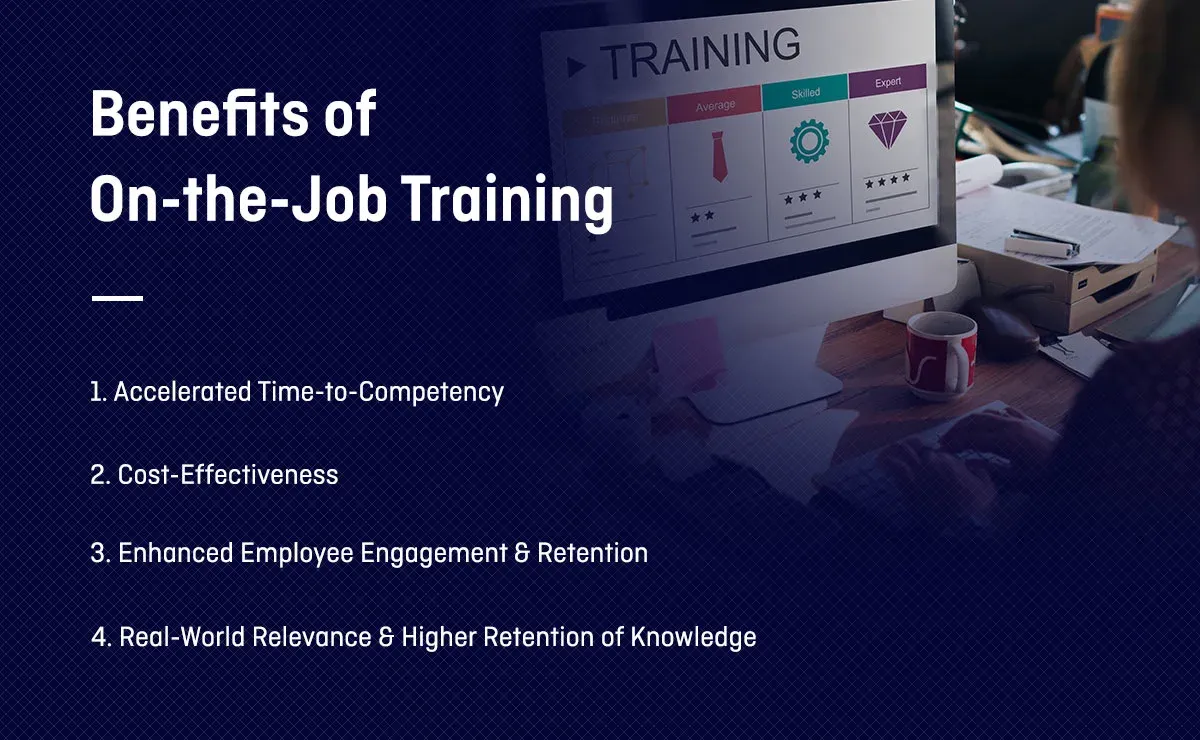What is On-the-Job Training?

The modern competitive business world demands organizations with a flexible, innovative, and cost-efficient workforce. The most important thing is to develop employees who can learn and apply new skills very quickly. The conventional training is usually ineffective, particularly in positions that require practical knowledge. This is exactly the reason why on-the-job training (OJT) is important.
OJT does not divide training and work; rather, it integrates learning into the workplace, enabling the employee to learn and develop skills as he performs actual duties under the supervision of an expert.
This guide delves into OJT's core: its definition, benefits, implementation examples, step-by-step program design, challenges and solutions, the role of technology, evaluation metrics, and future trends.
Understanding On-the-Job Training?
On-the-job training (OJT) is a practical learning approach where employees develop the expertise, insights, and abilities needed for their roles while working. Unlike classroom-based or off-site instruction, OJT immerses the trainee in real work scenarios, using actual tools, processes, and equipment. Under the guidance of a more experienced colleague, training manager, or professional trainer, employees learn to observe tasks, practice them under supervision, and receive immediate feedback.
Key characteristics of OJT include:
- Contextual Relevance: Trainees work with the exact systems, machines, and procedures they will encounter in their day-to-day roles, bridging the gap between theory and practice.
- Practical Application: Learning occurs in real time, real situations. For instance, when training a trainee to operate a CNC machine, it is done on-site rather than in a simulated laboratory.
- Immediate Feedback: Supervisors or mentors give immediate correction and reinforcement to trainees and assist them in perfecting their skills before they develop unwanted habits.
- Cost Efficiency: Organizations can reduce the cost of using external facilities, hiring third-party trainers, or traveling by leveraging available workplace resources, including equipment, software, and staff.
- Professional Orientation: OJT introduces new employees to the organizational culture, work rhythm, and unwritten rules on the first day, promoting faster acclimation and team spirit.
In essence, OJT turns the work environment into a living-learning laboratory where skills can be learnt quickly, and trainees can transition into productive contributors with ease.
Benefits of On-the-Job Training
OJT provides many advantages to employers and their staff. Its most important advantages are discussed below:

Accelerated Time-to-Competency
- Since the trainees are exposed to tasks in their real workplace, they narrow the gap between learning and doing them almost immediately. The learning curve is considerably shortened with this on-the-job practice.
- Research indicates that OJT can save 30-50 percent of onboarding time compared to entirely classroom-based approaches.
Cost-Effectiveness
- Companies save on the cost of paying outside trainers, renting facilities, or accommodating off-site training.
- As trainees learn, they are also involved in managing some of the observed workloads, thereby reducing productivity losses.
Improved Employee Engagement/Retention
- A close collaboration with more seasoned colleagues provides both an atmosphere of support and an opportunity to enhance personal relationships, which, consequently, promotes morale and loyalty.
- When employees see a direct link between skill mastery and promotion or financial incentives, they feel valued and invested, which reduces turnover.
Real-World Relevance & Higher Retention of Knowledge
- The trainees work with the same tools, software, and workflows that characterize their job roles, and therefore, they retain more concepts than when in an abstract classroom-based instruction.
- Any mistakes are rectified immediately, and incorrect practices are not reinforced. This loop contributes to stronger knowledge retention and confidence.
Off-The-Job Training Vs. On-The-Job Training
Organizations usually use a combination of training methods, but OJT and off-the-job training are fundamentally different. The following is a comparative summary to help managers decide which method, or combination of methods, best suits them.
Aspect | On-the-Job (OJT) | Off-the-Job Training |
Location | It takes place within the real work setting (production area, workspace, or client location). | Takes place away from the core work environment (training centers, classrooms, eLearning platforms). |
Learning Method | Hands-on, experiential learning, where trainees perform real tasks under supervision. | Theoretical or simulation-based learning, which is taught through lectures, prerecorded modules, role-plays, and workshops. |
Trainer | In-house mentors who are experienced colleagues, supervisors, or training managers. | External instructors, academics, or certified trainers (potentially offsite). |
Cost | Generally lower cost as it leverages existing resources, in-house expertise, and equipment. | Often higher as it adds expenses for venues, travel, third-party trainer fees, and printed materials. |
Customization | Highly aligned to company-specific processes, culture, and tools. | More standardized or generic and may not reflect the organization’s unique workflows or tools. |
Feedback Loop | Immediate, real-time corrections, and reinforcement. | Feedback is typically delayed until after assessments, debriefs, or follow-up sessions. |
Applicability | Best for roles requiring practical, technical, or field-based skills. | Ideal for foundational knowledge, theoretical concepts, industry accreditation, or soft skills development. |
In practice, a blended learning strategy often yields the greatest impact. Basic theory and adherence issues may be taught through off-the-job training, and OJT may reinforce that training by immediately applying it practically.
On-the-job Training Steps
The successful implementation of OJT involves more than assigning a buddy and wishing that it will work. It is necessary to adopt a systematic approach that guides managers and HR professionals toward achieving consistency, quality, and quantifiable results. A step-by-step outline is provided below:
Step 1: Conduct a Training Needs Assessment
- Conduct role analysis and competency mapping to determine all important skills and knowledge gaps.
- Combine performance evidence (error rates, cycle times, customer feedback) to identify training priorities that have a high impact.
- Prioritize training goals based on strategic value, safety-critical activities, revenue-generating operations, or high-impact customer interactions.
Step 2: Define SMART Learning Objectives
- Make every objective specific, measurable, achievable, relevant, and time-bound.
- Match objectives with organizational goals- e.g., Within 8 weeks, call center trainees will have an 85% average first-call resolution rate with a CSAT of 90% or more.
Step 3: Design a Structured Training Plan
- Divide competencies into modules (e.g., machine setup, quality inspection, safety protocols, etc.) and place them in order.
- Develop checklists, SOPs, quick-reference guides, and any required sandbox or simulation setups.
- Find skilled workers who have the technical skill and the teaching ability. Deliver a one-day train-the-trainer session on the theory of adult learning, methodology of feedback, rubrics, and assessment.
- Allocate time to each phase (orientation, shadowing, guided practice, monitored independence), and build in buffer periods for trainees who need extra support.
Step 4: Conduct On-the-Job Training
- Present culture of the company, safety protocols, rudimentary workflows, and team formation.
- Have trainees watch SMEs do their job and allow mentors to tell them about important decision points and working particularities.
- Under close supervision, trainees can undertake tasks and check their progress using competency checklists to identify areas for improvement.
- As expertise increases, less direct supervision is needed; mentors conduct random audits and provide feedback.
- In jobs that need a wider range of skills, transfer trainees through similar functions- improving flexibility and familiarity with the organization.
Step 5: Monitor Progress & Provide Feedback
- Conduct the weekly mentor-trainee check-ins in which performance metrics (error rates, throughput) are reviewed, and goals are formulated.
- Do formal testing at the major stages (Week 4 and Week 8) that will include both practical demonstrations and short quizzes.
- Use two feedback loops: mentors can be guided, and trainees can be honest about the effectiveness of training.
- Record entries in an LMS or a shared tracking sheet, such as competency sign-off entries, assessment outcomes, and feedback notes.
Step 6: Measure ROI & Evaluate Effectiveness
- Use the Four Levels created by Kirkpatrick to evaluate trainee responses, learning performance, in-service performance, and overall business outcomes.
- Track KPIs like time-to-competency, error/defect rates, retention, supervisor satisfaction, and CSAT/NPS.
- ROI, which is calculated by subtracting net training costs (mentor compensation, material expenses, productivity dip) from net benefits (increased revenue, cost savings, improved quality), then dividing it by net training costs.
- Make competency rubrics more specific, revise schedules, reform trainers, and revise training resources using evaluation data.
Step 7: Support After Training and Provide Ongoing Learning
- Have mentor check-ins on a continuous basis, particularly when rolling out new products or during seasons of high demand.
- Establish communities of practice (e.g., online forums and quarterly lunch-and-learns) in which the employees discuss best practices and solve emerging problems.
- Provide just-in-time reinforcement through refresher workshops and microlearnings (videos 2-5 minutes, infographics on paper).
- Leverage OJT performance data to identify high-potential employees for succession planning and advanced training tracks.
Examples of On-the-Job Training
OJT can take various forms, and that, too, depending on the role, industry, and corporate culture. The subsequent seven techniques explain how companies use OJT to nurture talents in a real, practical world:
- Orientation: On the first day, new employees are on-site, learn about company policies, work processes, and basic safety measures, and shadow a senior worker.
- Job Rotation: This practice is where employees move through various roles or departments within a given time (e.g., one month in the production department, one month in the quality control department, one month in the maintenance department).
- Mentoring/Coaching: It is a program in which a junior employee is assigned a senior, experienced mentor who guides, provides feedback, and demonstrates routine assignments to the junior employee.
- Internship: Learners and new graduates are assigned real work to do under supervision; e.g., a marketing intern would be assigned to create social media posts for a live campaign.
- Simulated Sandbox Training: Trainees practice a replica or virtual version of actual systems (e.g., IT staff troubleshoot a dummy network; nurses work with high-fidelity patient mannequins).
- Apprenticeship: Over an extended period (often 1–4 years), apprentices split time between classroom instruction and hands-on work under a skilled tradesperson’s supervision.
- Team Collaborative Projects: Small groups of new employees work on a real assignment—like improving a production process—under the leadership of a project coach.
Disadvantages of On-the-Job Training
Although there are numerous benefits of OJT, it has certain limitations that need to be overcome by the organization:

Poor Quality of Training
- Variability among mentors may lead to inconsistent skill development among trainees.
- Unwritten, unaccounted practices would create a tendency to maintain outdated or sub-optimal work processes.
Possible Productivity Interferences
- The time mentors spend in training may also reduce their output, creating a bottleneck, particularly when not planned wisely.
- Starter shadowing stages can disrupt normal operations because mentors frequently stop to provide clarifications on assignments.
Risk of Transferring Outdated Practices
- In the absence of a formal process to update materials, mentors may pass on legacy techniques that are no longer best-in-class.
- In rapidly evolving industries, OJT content can quickly become obsolete if not audited regularly.
Limited Scalability & Consistency
- Multi-site organizations struggle to ensure all mentors teach to the same standard—geographic and cultural differences exacerbate these gaps.
- As headcount grows, finding enough qualified mentors becomes challenging, particularly for niche or specialized roles.
Difficulty Measuring Long-Term ROI
- Isolating OJT’s direct impact from other factors (e.g., previous experience, concurrent e-learning) can be complex.
- The long-term gains, including the increased retention or customer loyalty, require a long-term data collection and analysis process.
The Use of Technology in On-the-Job Training
The technology has shifted from a supporting element to a strategic facilitator of OJT, increasing scalability, consistency, and learner interest. Four major types of technology that influence the contemporary OJT programs are listed below:
- Digital Adoption Platforms (DAPs): Digital adoption solutions are also called digital adoption platforms (DAPs), which incorporate interactive guidance into enterprise software (e.g., CRM, ERP, and proprietary software). Trainees are shown step by step on-screen through the use of overlays, tooltips, and task lists.
- Learning Management Systems (LMS): An LMS is a centralized server system used to store, deliver, and monitor the training content, including eLearning modules and videos, competency tests, and job aids. This ensures that all trainees access the same foundational content before transitioning to hands-on practice.
- Augmented Reality (AR) & Virtual Reality (VR): AR adds digital data, such as text, 3D models, and animations, to a trainee's view of the real world, whereas VR simulates the real world by creating a virtual environment. It helps make the experience more immersive, which increases concentration and retention, especially on complicated, multi-step tasks.
- Mobile Microlearning & Just-in-Time Tools: Mobile microlearning refers to the delivery of short, targeted lessons in the form of 2-5 minute videos, interactive infographics, or single-question quizzes, accessible on a smartphone or tablet. Just-in-time devices help trainees access bite-sized knowledge exactly when it is needed.
FAQ
Q1. What is on-the-job training in human resource development (HRM)
Ans: On-the-job training (OJT) in HRM is a program that involves employees acquiring job-specific skills as they perform their day-to-day duties. With the assistance of a mentor or supervisor, trainees can put into practice tasks such as using actual tools, systems, and processes on the job.
This practical method speeds learning through instant feedback, reduces wasted training time, and helps new recruits adapt quickly to the company culture and practices.
Summing Up
On-the-job training (OJT) is considered one of the most effective, least expensive, and outcome-oriented means of staff upskilling. It speeds up learning, reduces costs, and enables employees to learn to handle real-world tasks quickly.
However, successful OJT cannot be achieved by merely placing new people with experienced workers. It involves a systematic arrangement of the plan, properly set learning goals, regular mentoring, and the provision of supplementary technology.
In the modern-day, competitive and fast-moving business world, companies that invest in properly implemented on-the-job training are better positioned to build a strong workforce that is well-suited to the tasks at hand and to projected growth.

